
Original Link: https://www.anandtech.com/show/2624/debunking-power-supply-myths
Debunking Power Supply Myths
by Christoph Katzer on September 22, 2008 3:00 AM EST- Posted in
- Cases/Cooling/PSUs
Introduction
Anyone building a computer system should eventually pose the question: How much power does the system actually require? This is an important consideration, since it's impossible to choose an appropriate power supply without actually knowing the demands of your system. Unfortunately, many users take the easy way out: just grab a 500W power supply and call it good. If you really want to be safe, you can even grab on 800W PSU... or if you plan to run multiple graphics cards perhaps you really need a 1000W unit, right?
If people really took the time to examine system power requirements, we would see a tremendous increase in sales of 300W to 400W PSUs. The truth is that the vast majority of systems would run optimally with such a "small" power supply. Even if you're running SLI/CrossFire, you don't actually need a 750W power supply. (Of course, we recommend purchasing a good quality power supply, as there are certainly "750W" PSUs out there that can't reliably deliver anywhere near that much power.) To help dispel some myths relating to power requirements, we've put together a couple of charts.
| GPU Power Consumption* | ||
| Manufacturer | Idle | Load |
| NVIDIA GeForce 9600 GT | 49W | 107W |
| NVIDIA GeForce 8800 GT | 64W | 115W |
| NVIDIA GeForce 9800 GTX | 79W | 116W |
| NVIDIA GeForce 9800 GX2 | 90W | 179W |
| NVIDIA GeForce 8800 Ultra | 100W | 186W |
| ATI Radeon HD 3650 | 17W | 32W |
| ATI Radeon HD 3850 | 53W | 82W |
| ATI Radeon HD 3870 | 62W | 92W |
| ATI Radeon HD 2900 XT | 67W | 104W |
| ATI Radeon HD 3870X2 | 55W | 130W |
* Actual power consumption for the graphics cards only. Results taken at idle on the Windows desktop and under full load running the Fur benchmark.
| CPU Power Consumption** | |||
| Manufacturer | Idle (EIST or CnQ Enabled) | Idle | Load |
| Intel Core 2 Duo E4500 | 14W | 17W | 36W |
| Intel Core 2 Duo E8500 | 18W | 22W | 43W |
| Intel Core 2 Quad Q9550 | 19W | 23W | 60W |
| Intel Core 2 Extreme QX6850 | 29W | 32W | 103W |
| Intel Core 2 Extreme QX9770 | 26W | 56W | 86W |
| AMD Athlon 64 X2 5000+ | 33W | 47W | 89W |
| AMD Athlon 64 X2 6000+ | 25W | 74W | 160W |
| AMD Phenom X3 8750 | 50W | 67W | 86W |
| AMD Phenom X4 9600 BE | 29W | 36W | 101W |
| AMD Phenom X4 9850 BE | 38W | 53W | 126W |
** Actual power consumption for just the processor. Results taken at idle on the Windows desktop with either EIST/C&Q enabled or disabled, and full load generated using BOINC.
| Chipset/Motherboard Power Consumption*** | |
| Platform and Chipset | Load |
| Intel P35 (775) | 37W |
| Intel P965 (775) | 39W |
| Intel X38 (775) | 52W |
| Intel X48 (775) | 40W |
| NVIDIA 680i (775) | 46W |
| NVIDIA 790i (775) | 51W |
| NVIDIA 750i (775) | 59W |
| NVIDIA 780i (775) | 69W |
| NVIDIA 8200 (775) | 29W |
| AMD 690G (AM2) | 34W |
| AMD X3200 (AM2) | 35W |
| AMD 770 (AM2) | 40W |
| NVIDIA 570 (AM2) | 40W |
| AMD 790FX (AM2) | 42W |
| AMD 790X (AM2) | 43W |
*** Actual power consumption for the motherboard and chipset. Idle and load power do not differ by any significant amount.
Top-end graphics cards are clearly one of the most demanding components when it comes to power requirements in today's systems. Only heavily overclocked CPUs even come close to the same wattages. Note that the above chart only includes last generation cards; NVIDIA's latest GTX 280 requires even more power.
Looking at the processor side of the equation, Intel's Core 2 Duo/Quad/Extreme CPUs in general have very low power requirements. AMD's latest Phenom processors aren't far behind, however, especially in light of the fact that they include the memory controller rather than delegating the task to the chipset. We should also mention that part of the reason for the extreme power requirements on the X2 6000+ come from the use of an older 90nm process.
Naturally, motherboards also require a fair amount of power. Current motherboards average around 47W for socket 775 and 39W for socket AM2/AM2+, but features and other factors can heavily influence that number. Outside of their IGP solution, NVIDIA's chipsets tend to use more power than the competition; AMD chipsets on the other hand typically require less power. Again, numerous other aspects of any particular motherboard will impact the actual power requirements, including BIOS tuning options.
Hard drives and optical drives account for another 10 to 20W each. However, remember that hard drives are a relatively constant 10 to 15W of power draw (average is around 12W) since the platters are always spinning (i.e. idle), and movement of the drive heads during read/write operations (i.e. load) only increases power draw slightly. Optical drives on the other hand stop spinning when idle, requiring only about 5W, while during read or write operations they need around 18W.
RAM power requirements measured a constant 2W per DIMM, regardless of capacity (though clearly not including FB-DIMMs). That figure is estimated, unfortunately, as we could not measure DIMM power requirements directly; we measured power draw with two DIMMs and then again with four DIMMs to arrive at the reported figures. It's also not possible to easily separate memory power requirements from the motherboard and chipset, as they share many of the same power connections from the PSU.
Building Three Sample Systems
Okay, so far we have some basic power guidelines in place. Let's put these figures into practice and look at some actual system power requirements. We've selected components for three different systems, so let's examine how much power each one requires.
System 1:
Intel Core 2 Duo E4500, 4GB Memory, P35 chipset motherboard, ATI Radeon HD 3650, an optical drive, and one hard drive. Outside of perhaps the memory, this is representative of your modern entry-level computer system. At idle, this computer requires around 90W of power. Even when we put the pedal to the metal and put a full load on the graphics card, processor, and optical drive, we still have a total power consumption of only 140W.
System 2:
AMD Phenom X4 9850 BE, 4GB Memory, AMD 790X Chipset, ATI Radeon HD 3870X2, an optical drive, and two hard drives. Our midrange system roughly doubles our power requirements, and depending on the benchmark it will offer more than twice the performance of our entry-level machine. At idle with Cool & Quiet enabled, this system uses almost 168W of power, while it needs at most 341W when fully loaded.
System 3:
Intel Core 2 Extreme QX6850, 4GB Memory, NVIDIA 780i Chipset, NVIDIA GeForce 8800 Ultra SLI, an optical drive, and four hard drives. For our third example, we chose some of the most demanding products for testing. In particular, the 780i Chipset from NVIDIA has the highest power consumption of all chipsets we've tested so far, drawing a constant 69W. (There is of course some variation in power consumption even from chips of the same family, and the features and extra chips on each motherboard differ from manufacturer to manufacturer. Our particular 780i is an EVGA motherboard.) The idle power consumption for this setup is around 310W, and once we place of full load on everything power consumption increases to 544W.
Worth mention is that the second graphics card in an SLI/CrossFire setup never actually uses 100% of the theoretical maximum power consumption. We estimate power consumption based on the figures on page one, and the second GPU only runs at around 50% power at the desktop (i.e. half the idle power draw); adding a third GPU would result in an even lower load, since the third card is frequently underutilized. Likewise getting a full load on quad-core CPUs and multiple GPUs is not a typical scenario. It may be possible to draw slightly more power, but the above guidelines should suffice.
Do these numbers help clarify the situation? The first system has very low demands, and yet if we look at the PC market as a whole 90% of current shipping systems don't even provide the same level of hardware as system one. Even with that fact accepted, the question remains: what sort of power supply should you choose for such a system?
That's the next topic of discussion, and we want to show some simple ways to help you choose the correct power supply for your needs. For the moment will put aside other important factors like DC output stability, ripple and noise, and overall quality and focus on choosing an appropriate power supply. Key factors in this decision will be the efficiency curves and noise levels.
Efficiency Explained
All power supplies have a specific efficiency curve, which we show in our reviews. As an example, we will use the Cooler Master UCP 900W power supply. Here is the efficiency curve we measured during testing:
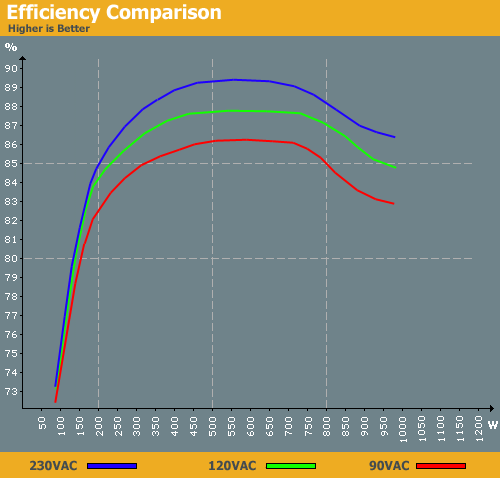
Efficiency is the output power divided by the input power, as there is a certain amount of power lost during the AC to DC conversion. The x-axis shows the power supply load in Watts and the y-axis shows efficiency. Let's include our three sample systems in the chart see what sort of efficiency they would get with this power supply.
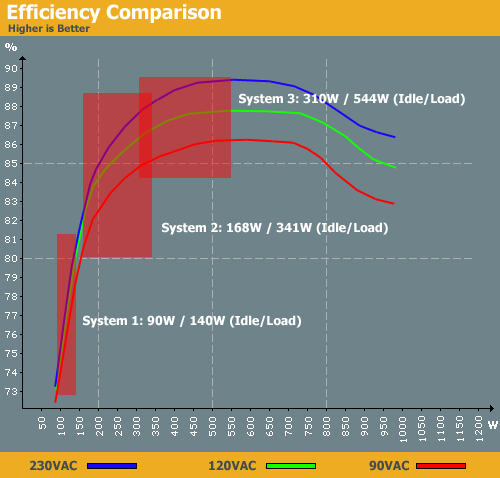
The first system causes this high-performance power supply to only run at 73% to 81% efficiency, depending on input voltage. Obviously, there's absolutely no need for a 900W power supply if you're running this type of computer.
The midrange system looks quite a bit better, allowing the PSU to run at 80% to 88% efficiency, although the latter only occurs at maximum load. Considering the vast majority of systems rarely run at 100% load most of the time, real-world efficiency will average closer to 82%. Office work and Internet surfing in particular will be at that level.
For the third system, a 900W power supply actually might start to make sense. It's still more than you need, but having a bit of extra room to grow isn't a bad idea. This system idles at over 300W, so it achieves a minimum 86% efficiency with 120VAC. When running a game or other demanding task, the PSU is finally able to reach its potential and provide 89% efficiency with 230VAC (or 87.5% with 120VAC).
The quick summary then is that if you don't have a system that uses 350W of power when idle, it's probably not worthwhile to purchase this type of power supply. Our high-end sample system more or less meets this qualification, and if you were to take such a system and overclock it, these high-end power supplies are actually required. The 8800 Ultra is one of the most demanding graphics cards currently available; however, the GTX 280 appears to require even more power, making that another candidate for this sort of PSU. (Unfortunately, our power supply testing labs didn't have the latest GPUs available for testing.)
What about Noise?
Efficiency isn't the only aspect of power supply performance to consider. Noise levels are also important. Sticking with our previous example of the Cooler Master UCP 900W, we get the following chart:
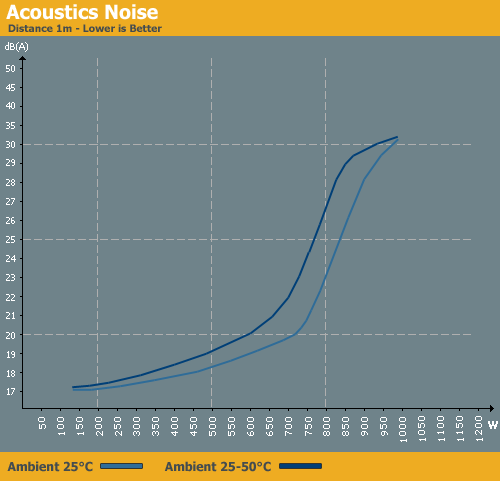
All three of our test systems allow this power supply to remain virtually silent. Even with our high-end system, power supply noise should not be much of a concern. In order to achieve a power draw of 550W, you will need to have a lot of power-hungry components, and these will almost certainly drown out any noise created by this particular power supply. Naturally, this is one of the benefits of choosing a power supply rated much higher than what you actually need: it will always stay virtually silent.
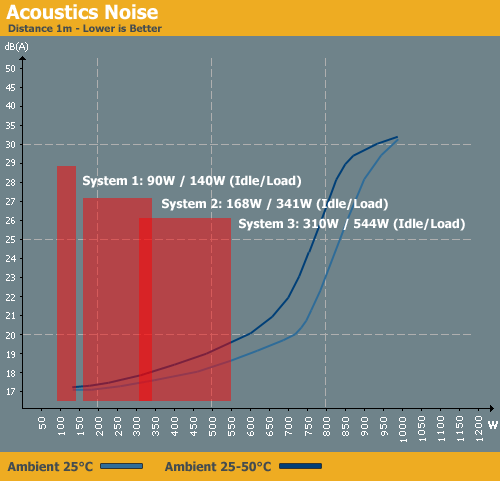
Any of our three sample systems will allow this power supply to run at less than 20 dB(A). Not surprisingly, this is the sort of comment we see on forums. "I have PSU XYZ, and I never hear it when my system is running!" That might be true, but without knowing the system components and operating load, such a statement provides the very little useful information -- especially when discussing an 800W or larger PSU. We prefer to push power supplies to their limits to see what actually happens when you begin to tax them. Midrange and high-end systems almost always have plenty of other fans that will drown out such a power supply.
Making Compromises
What we have learned from the preceding PSU example? A higher rated power supply will run much quieter if it runs at less than 50% of its rated output, but you don't want the rating to be too high or else efficiency will drop. Now we come to the more complicated part of choosing the right power supply for a new system. You need to make compromises between achieving optimal efficiency and maintaining a quiet working environment. If that is your goal, our high-end sample system is a perfect candidate for a 900W power supply like the Cooler Master UCP 900W. Efficiency is very good throughout the operating range and noise levels will be far lower than the ambient noise from the rest of the system. What we want to do now is go through the three sample systems and select an appropriate power supply.
Our entry-level system has very low power consumption, and unfortunately most power supply manufacturers completely ignore this market segment. Our goal today is to focus on quality power supplies that are readily available worldwide, and most manufacturers start with 500W models and go up from there. That limits our choices, but there are still a few options.
We can only be sure about efficiency if we've tested a power supply, so we will confine ourselves to such units. (Note that we have not necessarily published reviews on all of these power supplies, but we have tested them.) Our entry-level system uses an ATI Radeon HD 3650 graphics card, which means we don't need a PEG connector; that makes our choices a little easier. We'll focus on the following offerings:
- Thermaltake TR2 QFan (300W) actively cooled
- Enermax Pro82+ (385W) actively cooled
- Amacrox Calmer 560 (300W) passively cooled
- Corsair VX450W (450W) actively cooled
- Antec Earthwatts (430W) actively cooled

In the range of 90W to 140W, it's little surprise that the best efficiency is achieved by the two power supplies with the lowest rating (300W). The Thermaltake TR2 QFan places first in our results, and second place goes to the Amacrox Calmer 560. The Enermax takes third place, Corsair is in fourth, and Antec ranks at the bottom of these five options. If it were possible to find a 250W power supply with similar performance at a lower price, that would be even better, but it's just not possible these days. That takes care of efficiency, but let's look at noise levels.
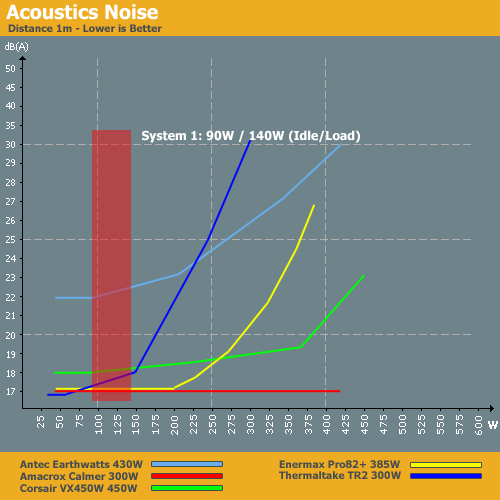
In the same range of 90W to 140W, the Amacrox Calmer 560 and Enermax Pro82+ are the best performers, with the overall crown going to Amacrox, since the Calmer 560 is passively cooled. The Thermaltake TR2 QFan and Corsair VS450W aren't too far behind, at only 18 dB(A) max, while Antec brings up the rear again.
Looking at the above two charts, the Thermaltake TR2 QFan is a perfect candidate for our entry-level system. However, if you instead prefer silence, we would go ahead and pick up the Amacrox Calmer 560. The HD 3650 is also available with passive cooling, so you will never have to complain about computer noise. In fact, I have that exact setup and use it daily as my system for web surfing and writing articles.
As the graphs show, there's still plenty of performance available, so we could even make a few system upgrades down the road. In truth, we could run this sort of system with a 200W power supply, but there are no quality PSUs available in that range. The desire for quality is what led us to select the Amacrox, Thermaltake, Enermax, Corsair, and Antec offerings, as they all provide excellent voltage regulation and overall quality.
PSUs for Midrange Systems
Our midrange system opens up a lot more in the way of potential power supplies, as there are far more manufacturers building 400W to 500W PSUs. Our idle power consumption in this case is 168W, which is quite high when compared to the 120W a high-end system would have used a few years back (i.e. AMD Athlon 64 4000+ and NVIDIA GeForce 7800 GTX under full load). However, times change and we see increased power requirements along with performance improvements.
Our selection of power supplies uses the same criteria as before. We will also see how our entry-level power supplies and all this sort of system.
- Cooler Master Silent Pro (500W) actively cooled
- Corsair HX520W (520W) actively cooled
- Corsair VX450W (450W) actively cooled
- Enermax Pro82+ (585W) actively cooled
- Enermax Pro82+ (625W) actively cooled
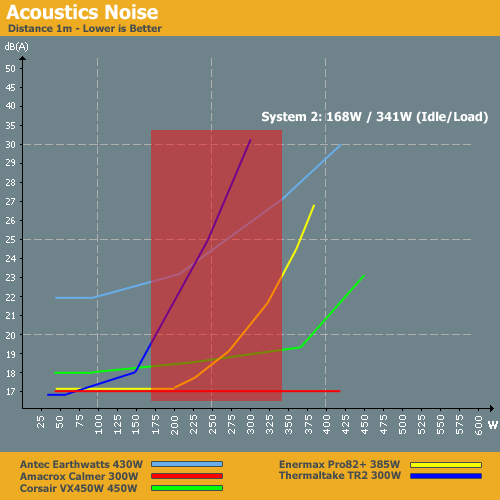
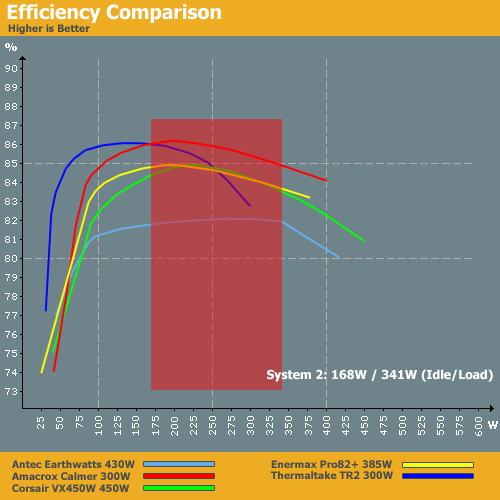
In terms of efficiency as well as the ability to supply sufficient power, all of the power supplies are able to run this midrange setup except for the 300W Thermaltake unit. The Antec Earthwatts has been around for a while, so it's not surprising that it doesn't perform as well as newer models, but it still delivers decent if not great efficiency. Noise levels are a different matter, and we would be inclined to avoid most of the entry-level PSUs. If noise isn't a consideration, all but the Antec will work; however, the Corsair VX450W performs best out of these units in so we will carry it along to the next level and include it with the midrange offerings.
Efficiency is Not the Issue

With the addition of some higher performing power supplies, efficiency clearly shouldn't be the overriding concern for a computer like our midrange system. The Corsair VX450W doesn't look as good in this graph, although 83% efficiency certainly isn't anything to cry about. The newer models all reach efficiency of around 85% to 86% throughout the midrange system load. Comparing the two scenarios, outside of PSUs that simply can't provide enough power it's not necessary to move up to a higher performance power supply. You want to look at other aspects such as features, warranty, and noise levels before making a decision.
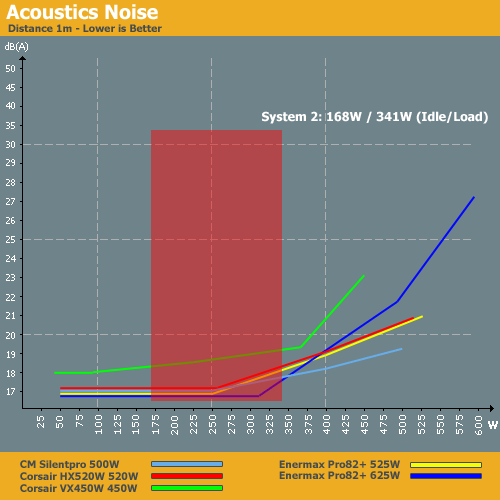
In terms of noise levels, all of these units perform very well and can provide a quiet computing environment. We also see a clear separation between the entry-level PSUs in the midrange PSUs in this chart, since the midrange units are running a 75% load at worst. Again, if you've had the mindset that 600W and higher PSUs are required for modern midrange systems, the above charts should help dispel that myth. If you can find a good quality 400W PSU, it can easily power a midrange system. However, 500W PSUs generally make the best fit, as they provide optimal efficiency and lower noise.
PSUs for High-End Systems
Even though our high-end system consumes more power, we used the same graph layout. That means the resulting graphs stop at 600W, despite the high-end PSUs all being capable of providing more power than that. Our high-end system sports an SLI setup using two NVIDIA 8800 ultra cards; 3-way SLI would be a bit more demanding, but we don't feel it's a good indication of what people are actually running. The third card would also only add another 50W to 90W of power consumption to our system, since the third card is rarely taxed as much as the first GPU.
- Antec NeoPower Blue (650W) actively cooled
- Antec Signature (850W) actively cooled
- Silverstone Decathlon (700W) actively cooled
- Zalman ZM850HP (850W) actively cooled
- Enermax Pro82+ (625W) actively cooled
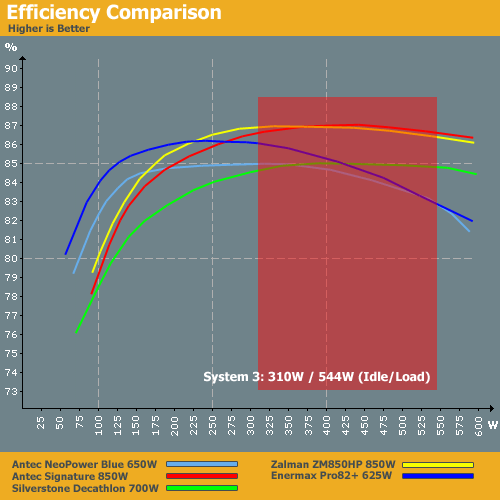
We've included the Enermax Pro82+ 625W from the midrange selection as well. Again, efficiency is not the major issue when it comes to choosing between these products. The two lowest rated power supplies -- Antec NeoPower 650W and Enermax Pro82+ 625W -- are less efficient over the tested range, but that's expected. The results all of her around 85% to 87% mark, and one or 2% difference really isn't going to matter much. Still, the Zalman and Antec 850W units place at the top of this chart.
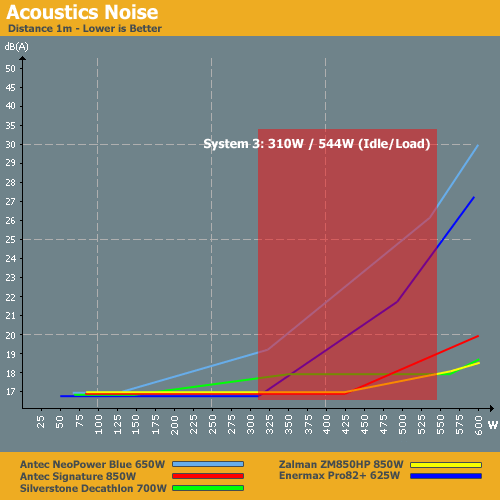
Again, the two power supplies with the lowest output rating perform worse in this test, generating much more noise than the competition. The higher rated units don't have to work as hard, since they are running at a medium load. Those three PSUs remain very quiet along with providing better efficiency, making them the better for a high-end setup. The Zalman and Antec Signature 850W units would be our choice, if only for the extra headroom. Either PSU would have no difficulty with a 3-way GPU setup, provided you have sufficient PEG connections available. That brings up the next topic of discussion.
Connectors and the 12V Rail Issue
Okay, we've chosen a few power supplies for our three test systems, but so far we've only looked at performance. There are still two additional issues that can affect your choice of power supply. We have previously shown that it is possible to run even high-end systems with a much lower rated power supply than you might expect. However, look at the offerings from the various manufacturers and you will frequently find that there are insufficient connectors for some configurations. The second issue involves the 12V rail(s), which is primarily responsible for powering the processor and graphics card(s).
Let's start with the first issue: having enough connectors. It is certainly possible to run a GeForce 8800 Ultra using only a 400W power supply; however, no one makes a 400W PSU with the necessary two PEG connectors. In fact, some power supplies in this range might not even have a single PEG connection. You could always use a Molex to PEG adapter(s), but you're probably better off selecting a different power supply.
Our entry-level system used the ATI Radeon HD 3650, which is a nice choice because it doesn't require any PEG connector. In the future users might want to upgrade graphics cards, however. The good news is that all of the entry-level PSUs be selected include a single 6-pin PEG connector, so they should be sufficient for powering up to a midrange (8800 GT/HD 3850) graphics card. If all you need is an average computer system, these power supplies will work fine.
The second issue is the amount of power the unit needs to provide in order to port graphics cards that use a single 6-pin jack. We could have included more cards, but for this example we've selected ATI's HD 3850/70 and NVIDIA's GeForce 8800 GTS and 9600 GT. We've created a table showing how much power these cards consume and where this power comes from under full load.
| GPU Power Requirements by Connector | |||||
| Vendor and Chip | Through 6-pin Jack |
Through PCI-E Slot |
Total Power | ||
| ATI Radeon HD 3850 | 4.4A | 52.8W | 2.4A | 28.8W | 82W |
| ATI Radeon HD 3870 | 5.1A | 61.2W | 2.6A | 31.2W | 92W |
|
NVIDIA GeForce 8800 GTS
|
7.2A | 86.4W | 4.8A | 57.6W | 144W |
| NVIDIA GeForce 9600 GT | 4.9A | 58.8W | 4.0A | 48.0W | 107W |
We need to check if the power supplies come with either one or two 12V rails. PSUs with two 12V rails usually have one rail connected to the 6-pin PEG connector and the other running the 24-pin ATX connector. The 24-pin ATX connector has two yellow cables that supply 12V, and both of these cables supply the PCI-E slots with power. The increasing power requirements of modern GPUs was the driving force behind the switch from 20-pin ATX connectors to 24-pin connectors. Some power supply manufacturers include different color markings on the 12V cables to differentiate rails, so if you have such a power supply you should make sure you connect components to a rail that has sufficient remaining juice.
It's important to have one 12V rail supply the CPU with power and the second rail for the PCI-E slots and 6-pin connector. Unfortunately, many companies make a tremendous mistake when it comes to power distribution. We have seen several power supplies that use one 12V rail for the 6-pin PEG connector and then a second 12V rail for the CPU and 24-pin ATX connector. That means if you have a graphics card that doesn't include a 6-pin jack, both the CPU and GPU will use the same 12V rail for power. In this case, the second 12V rail goes completely unused, and users risk drawing too much current on the remaining 12V rail. In addition, how much power a GPU draws from the 6-pin connector and how much it takes from the PEG slot varies.
Checking the labels of the entry-level units, we see that our selected power supplies should all have no difficulty running any of the above GPUs. Power supplies like the Corsair VX450W that has a single 12V rail have the advantage of being able to fully utilize the rated 33A.
Connectors and the 12V Rail Issue, Cont'd
As a second example, let's take our high-end system. This requires more power, making it a little more difficult to find an appropriate power supply -- especially if you want to run 3-way SLI. NVIDIA initially only certified 1200W power supplies for that sort of setup, but Corsair was eventually able to receive this certification for a 1000W unit. To run a 3-way SLI setup, we need at least six 6-pin PEG connectors, so let's start by looking at the number of connectors available on our high-end PSUs.
| PSU PEG Connectors | |||
| Manufacturer and Name | # of 6-pin PEG Connectors | # of 6/8-pin PEG Connectors | Total |
| Antec NeoPower Blue | 1 | 1 | 2 |
| Antec Signature | 2 | 2 | 4 |
| Silverstone Decathlon | 4 | 0 | 4 |
| Zalman ZM850HP | 2 | 2 | 4 |
| Enermax Pro82+ | 0 | 4 | 4 |
As you can see, none of the power supplies we listed are able to run more than two GPUs, since none of them have the available six PEG connectors. We still don't recommend 3-way SLI, has the advantages over two-way SLI are sketchy at best. Regular SLI also has the advantage of only requiring four 6-pin PEG connectors even for the highest-end GPUs. All of the listed power supplies can meet this requirement, except for the Antec NeoPower Blue.
For the second 12V rail issue, here's a look at the specific power requirements of our graphics card, the GeForce 8800 Ultra:
| GPU Power Requirements by Connector | |||||
| Vendor and Chip | Through 6-pin Jack |
Through PCI-E Slot |
Total Power | ||
| NVIDIA GeForce 8800 Ultra | 9.4A | 112.8W | 6.1A | 72.2W | 186W |
If you plan to run multiple cards, you can just multiply 186W by the number of cards in the system. We found during testing that the cards don't consume equal amounts of power. The first GPU always uses the same amount of power, whether in a single or SLI configuration. The second and third cards however require much less power, which also means that they are doing less work. In testing a variety of benchmarks and games, we saw that the second and third graphics cards only use 40% to 50% of the power of a single GPU.
One thing is obvious when looking at the power consumption of the single GeForce 8800 Ultra: the maximum power draw is only 15.5A, which you can get from a single 12V rail. Most higher-end power supplies have multiple 12V rails, which should make distributing power to your GPUs even easier. As long as the 24-pin ATX connector and the different 6-pin PEG connectors run on different 12V rails, none of the rails should end up with an excessive load. That takes care of the 300W power requirements mentioned by GPU vendors.
If you take the high-end system (with an optional third graphics card), you are looking at one of the most demanding systems available. Of course, you could always overclock the processor and graphics cards, which might increase power requirements by another 30%, but we'll leave that topic for another day. We were able to run this test system with a normal 850W power supply, and even with a reasonable load the PSU fan didn't make that much noise. Most of the high-end PSUs we've chosen for this article could also run a triple-SLI setup, provided they have sufficient connectors.
At the beginning of the year, we requested a special AnandTech Edition of PC Power & Cooling's Turbo Cool 860W power supply with six PEG connectors, specifically for running a triple-SLI setup. We have been using the power supply since then with three GeForce 8800 Ultra cards, an Intel Core 2 Extreme QX6850 CPU, and 12 Western Digital hard drives without any problems. Clearly, quality of construction and number of connectors are far more important than a silly wattage rating.
Final Thoughts
Building a system these days feels a lot more complex than it was a few years ago. There are many more components in the market, with new ones announced every week, and there's also a lot of overlap. It's nice that some manufacturers are now including advice on power requirements on their products, but that doesn't mean you should take this information at face value. A processor vendor might list a TDP of 150W, but that doesn't necessarily mean that particular processor will actually use 150W. It is more of a rough indication, but at least it's better than nothing.
We have tested processors from AMD and Intel and we have to conclude that the Intel parts are usually far below the listed TDP, where is the AMD parts are sometimes higher. The same applies to graphics cards, but in this case we have a huge difference between the various loading mechanisms. For example, we couldn't reach maximum load on an 8800 Ultra using any current DirectX 10 game, but the Fur benchmark was able to do so. To achieve a similar load, you need to balance frame rates, anti-aliasing, anisotropic filtering, and resolution. High frame rates without AA/AF typically don't put as much of a load on the GPU(s), and likewise high AA/AF settings with low frame rates usually result in lower power consumption. In testing, it seems like maintaining 80 to 100 FPS while increasing AA/AF levels resulted in worst-case power consumption -- though obviously that can vary by application/game.
Something else you need to keep in mind when building a new system is your hard drive power requirements. Most power supplies provide information about their power consumption on the label, although they list current rather than wattage. The power requirements for a hard drive are quite low compared to processors and graphics cards, but remember that hard drives typically need three times as much power during startup as they use during normal use. This only occurs for a split second, so this spike is only visible using an oscilloscope. However, this can cause problems with certain power supplies in combination with larger disk arrays.
Hopefully this article has helped to shed some light on what factors need to be considered when choosing a power supply. Our tests have certainly showed that most components to use nearly as much power as you might think. Look at the tables we've listed on the first page, and then use that information to figure out what sort of power supply you actually need.
Our three sample systems show that few if any people actually need anything more than 850W power supply, especially if you can get an appropriate number of connectors. About the only reason you should consider anything more is if you want to keep your power supply at a lower load, since optimal efficiency and lower noise levels usually come at around half the rated output. Overclockers might also want a bit of extra headroom. Otherwise, there's really no need for a 1000W power supplies, and certainly not those with even higher ratings.
Our power supply reviews include efficiency and noise level charts at various wattage loads. Using these, you can easily compare your own system to see what sort of efficiency and noise you would get. You might be surprised to learn that your intended high-end setup really won't make much use of that spiffy new 1000W PSU; you might be greener than you think!







